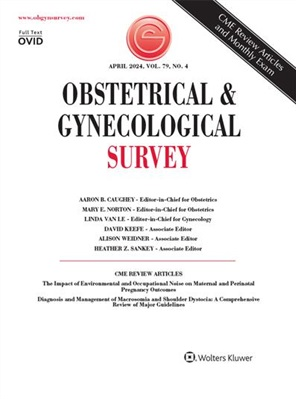Cervical Cerclage: A Comprehensive Review of Major Guidelines
IF 3.6
4区 医学
Q1 OBSTETRICS & GYNECOLOGY
引用次数: 0
Abstract
Importance Cervical cerclage (CC) represents one of the few effective measures currently available for the prevention of preterm delivery caused by cervical insufficiency, thus contributing in the reduction of neonatal morbidity and mortality rates. Objective The aim of this study was to review and compare the most recently published major guidelines on the indications, contraindications, techniques, and timing of placing and removal of CC. Evidence Acquisition A descriptive review of guidelines from the American College of Obstetricians and Gynecologists (ACOG), the Royal College of Obstetricians and Gynaecologists (RCOG), the Society of Obstetricians and Gynaecologists of Canada (SOGC), and the International Federation of Gynecology and Obstetrics (FIGO) on CC was carried out. Results There is a consensus among the reviewed guidelines regarding the recommended techniques, the indications for rescue CC, the contraindications, as well as the optimal timing of CC placement and removal. All medical societies also agree that ultrasound-indicated CC is justified in women with history of prior spontaneous PTD or mid-trimester miscarriage and a short cervical length detected on ultrasound. In addition, after CC, serial sonographic measurement of the cervical length, bed rest, and routine use of antibiotics, tocolysis, and progesterone are unanimously discouraged. In case of established preterm labor, CC should be removed, according to ACOG, RCOG, and SOGC. Furthermore, RCOG and SOGC agree on the prerequisites that should be met before attempting CC. These 2 guidelines along with FIGO recommend history-indicated CC for women with 3 or more previous preterm deliveries and/or second trimester pregnancy miscarriages, whereas the ACOG suggests the use of CC in singleton pregnancies with 1 or more previous second trimester miscarriages related to painless cervical dilation or prior CC due to painless cervical dilation in the second trimester. The role of amniocentesis in ruling out intra-amniotic infection before rescue CC remains a matter of debate. Conclusions Cervical cerclage is an obstetric intervention used to prevent miscarriage and preterm delivery in women considered as high-risk for these common pregnancy complications. The development of universal international practice protocols for the placement of CC seems of paramount importance and will hopefully improve the outcomes of such pregnancies. Target Audience Obstetricians and gynecologists, family physicians. Learning Objectives After participating in this activity, the learner should be able to identify the indications and contraindications of cervical cerclage; evaluate the prerequisites before cervical cerclage placement; and explain the strategies for perioperative and postoperative care after cervical cerclage placement.宫颈环切术:主要指引的全面检讨
重要性:宫颈环切术是目前可用于预防因宫颈功能不全引起的早产的少数有效措施之一,从而有助于降低新生儿发病率和死亡率。本研究的目的是回顾和比较最近发表的关于CC的适应症、禁忌症、技术和放置和移除时间的主要指南。证据获取对美国妇产科学院(ACOG)、皇家妇产科学院(RCOG)、加拿大妇产科学会(SOGC)、国际妇产科学联合会(FIGO)对CC进行了研究。结果经审查的指南对推荐的技术、抢救CC的适应症、禁忌症以及CC放置和取出的最佳时机达成了共识。所有医学协会也一致认为,超声指示的CC适用于有自发性PTD或中期流产史的妇女,超声检查发现宫颈长度较短。此外,CC后,连续超声测量宫颈长度,卧床休息,常规使用抗生素,胎解和黄体酮一致被劝阻。根据ACOG、RCOG和SOGC的建议,在确定早产的情况下,应切除CC。此外,RCOG和SOGC在尝试CC之前应满足的先决条件上达成一致。这两个指南以及FIGO建议有3次及以上早产和/或妊娠中期流产史的妇女使用CC,而ACOG建议在单胎妊娠中有1次及以上无痛性宫颈扩张相关的妊娠中期流产或妊娠中期无痛性宫颈扩张相关的妊娠中期流产或妊娠中期无痛性宫颈扩张相关的既往CC。羊膜穿刺术在抢救CC前排除羊膜内感染的作用仍然存在争议。结论宫颈环切术是一种产科干预措施,用于预防流产和早产,这些妇女被认为是这些常见妊娠并发症的高危妇女。制定通用的CC放置国际实践协议似乎至关重要,并有望改善此类妊娠的结果。目标受众:妇产科医生、家庭医生。参加本活动后,学习者应能识别宫颈环切术的适应症和禁忌症;评估宫颈环切置入前的先决条件;并解释宫颈环扎术后围手术期及术后护理策略。
本文章由计算机程序翻译,如有差异,请以英文原文为准。
求助全文
约1分钟内获得全文
求助全文
来源期刊
CiteScore
2.70
自引率
3.20%
发文量
245
审稿时长
>12 weeks
期刊介绍:
Each monthly issue of Obstetrical & Gynecological Survey presents summaries of the most timely and clinically relevant research being published worldwide. These concise, easy-to-read summaries provide expert insight into how to apply the latest research to patient care. The accompanying editorial commentary puts the studies into perspective and supplies authoritative guidance. The result is a valuable, time-saving resource for busy clinicians.

 求助内容:
求助内容: 应助结果提醒方式:
应助结果提醒方式:


